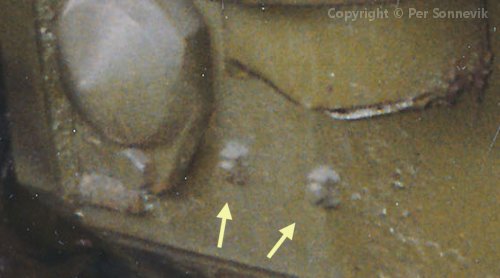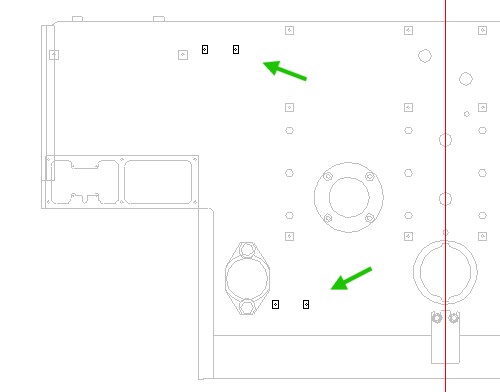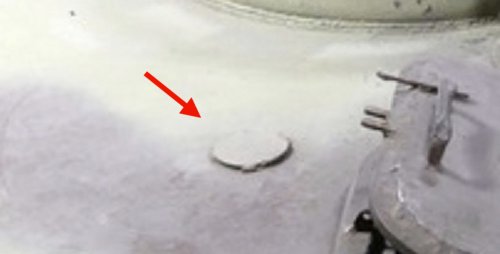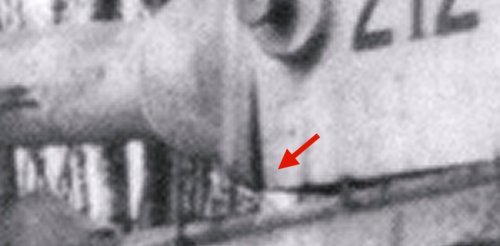Basic facts about "212"
This kit supplies decals for Tiger "212" of the 502nd. It was the second "212" owned by that unit. And this Tiger was not configured exactly as the artwork or the instructions tell you. Tiger "212" was a rare version of Tiger.
The story of "212" gives us a glimpse into the desperation of late-war Germany. In October 1943, the Tiger factory was producing about 50 Tigers per month. A proportion of them were Command Tigers, earmarked for new Tiger units. But those new units were not being created as fast as planned, because new Tigers were used to replace losses. A growing fleet of unused Command Tigers was kept near the factory, some of them months old.
And then, Henschel and Sohn's factory was damaged by a heavy bombing raid. Tiger production was set back by about a month. To fill the gap, that fleet of 18 finished Command Tigers was converted to normal ones, with as few changes as possible. For example the turret radio was removed so the MG could be installed there, but the 3-channel intercom was left in place.
Several of those converted Tigers have been spotted in wartime photos, and, amazingly, one of them survives today in a Russian museum. Tiger "212" was one of that group. It therefore had a mix of Command and standard features.
Special features of "212"


The tube for storing "star" antennas was removed from the rear wall of "212", but its four welded mounting points were left in place.
Tiger "212" had an antenna base on its left side, not an S-mine launcher. This base was intended for the Fu 7 long-range radio of Command tanks, but now it was used for the tank's standard Fu 5 radio.

"212" used to have an antenna base on its turret roof. It was removed during the conversion. Four small holes were left in the roof, and they were covered by a small circular plate welded over them. This example is in a Russian museum, and a wartime photo has been found also.

On the right side of Tiger "212", there used to be special insulated base for the "star" antenna of the Fu 8. It included a ceramic insulator in a cylinder that was sunken into the roof, and a tuning coil internal to the tank. These valuable parts were removed, leaving the cylinder empty. Although the cylinder had its own drain for rainwater, the removal of the insulator would have left a new hole in it. I'm not sure what was done about that. The surviving tank in Russia has a circular plate welded on that covers the entire cylinder, but this wartime photo shows the cylinder open to the elements; perhaps a smaller seal was welded inside it?
Command Tigers had some small features on their right side, near the antenna. There were two holders for a "mast" antenna, and a small chimney for the generator. Tiger "212" retained all of them.
The mantlets of these converted Tigers had an MG hole. The factory must have either replaced or drilled out their Command mantlets.
Optional features of "212"

There are no photos showing "212" from the front, so we might never know which of the three kinds of mantlet it had. But there are two clues. Firstly, the unusual mantlet with a wide thick area was no longer being made at the time of this Tiger's original construction. So, even if "212" had its original mantlet, drilled for an MG, it wouldn't be that type. Secondly, the flat mantlets of the Tiger (P) had a small notch cut into their corner. We can see that "212" had no such notch. Therefore "212" had a standard mantlet.
Two different kinds of loader's hatch were being fitted to Tigers at this time, more or less at random. We can't see what kind was on "212".
S-mine launchers and headlamps were removable features of the Tiger, and were often absent. Our photos of "212" show it in combat configuration, with the mine launchers installed and the headlamps removed. But this is just a single point in time.
It was common to remove the front roadwheels from Tigers to prevent them scooping mud into the system. Photos of the 502 battalion's Tigers show us that they usually did that. The photos of "212" itself show a removed wheel on its right side, while on its left side the three forward outer wheels are all missing. This kit does not supply the hub that was exposed by removed wheels.
"212" was from the end of the "Early" production period and it never had the smoke launcher system. You should remove all traces of it from the turret wall and roof.
Time-related features of "212"
"212" had no openings above the driver's visor.
"212" must have had the new type of engine cover with a triangular panel.
"212" did not carry its Feifel filters in the photos, and given the environment it operated in, they would not have been needed.
"212" had seven track holders on its turret.
"212" surely had a turret roof periscope.
As a final "Early" Tiger, this tank should have had the final type of hub on its sprocket wheels. The kit does not include that.
"212" would have had support legs on its engine hatch. The kit does not provide them.
When "212" was built, the outlet grilles on the rear deck were identical. But the kit has the old mirrored grilles.
"212" had a HL230 engine. That engine requires a starter adaptor plate with two holes, and we can see exactly that plate in photographs. The kit does not provide one.
"212" had no welded frames on the rear hull wall. But the kit does have them, and they should be sanded off.
"21s" had the final type of folding rear mudflaps. They are the ones provides in this kit.
"212" very probably had no bolts flanking its hull MG.
"212" had the usual sheet-metal exhaust shields, and a cap (part S6) suspended over the exhaust outlets.